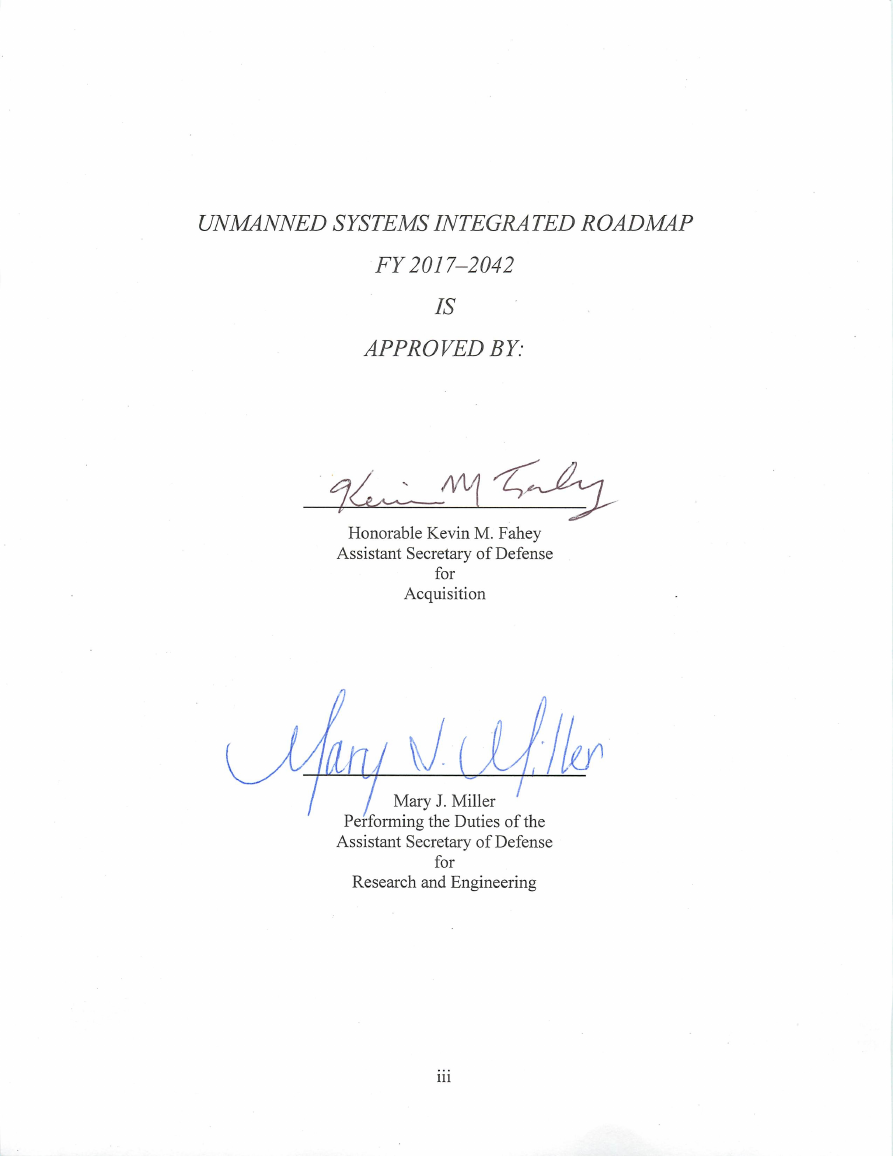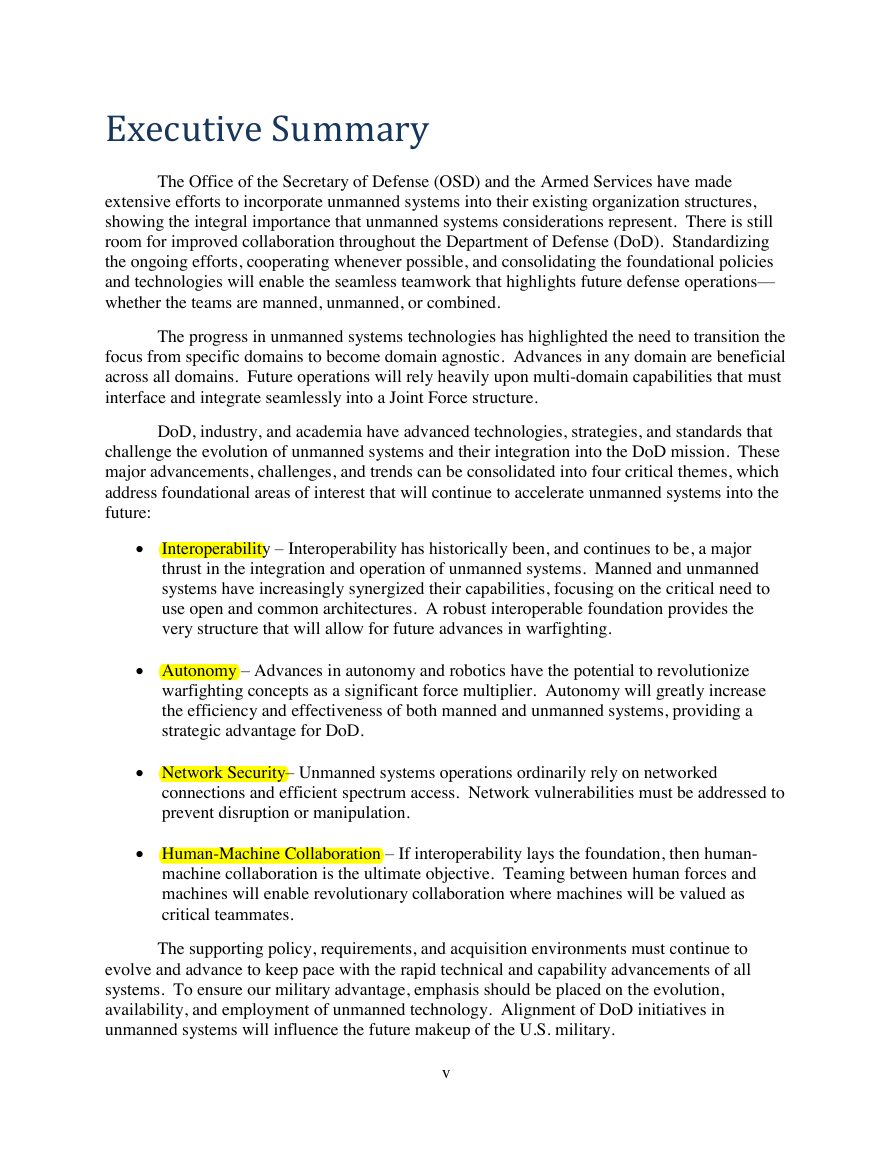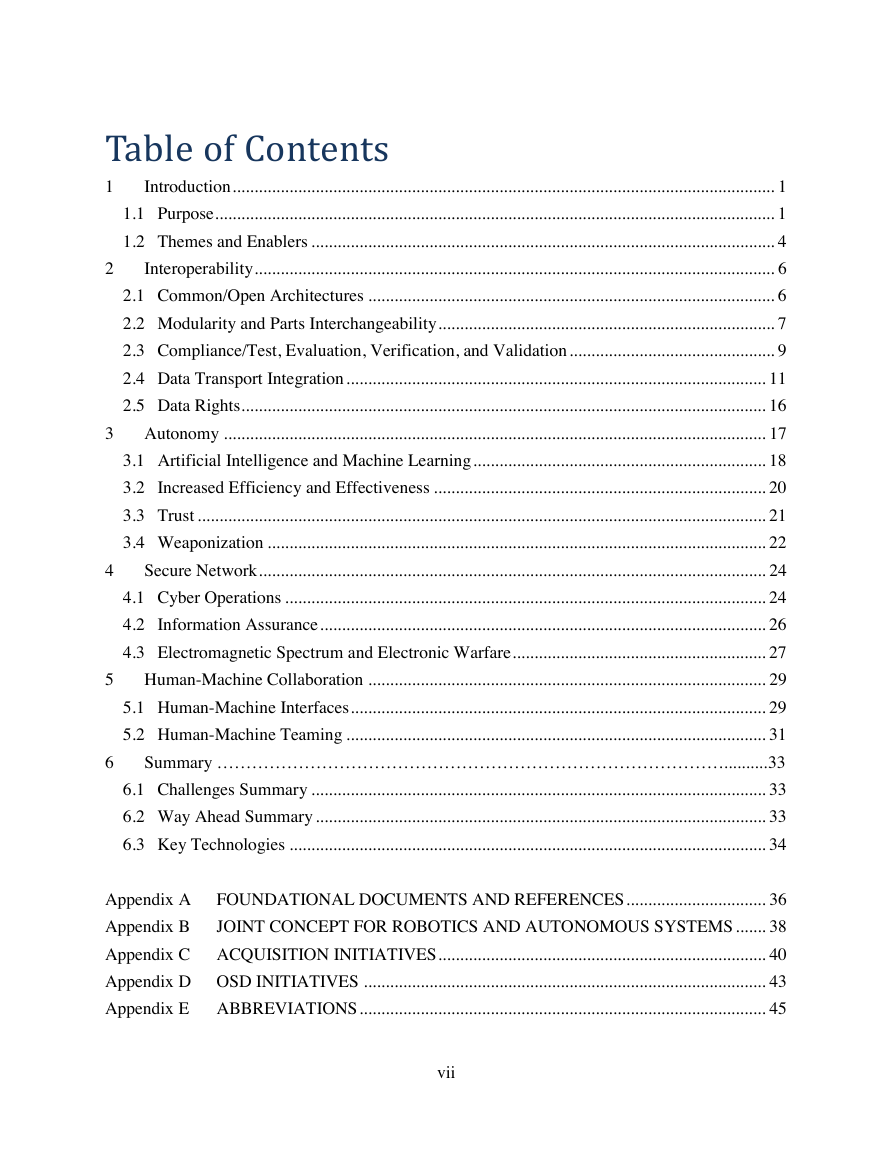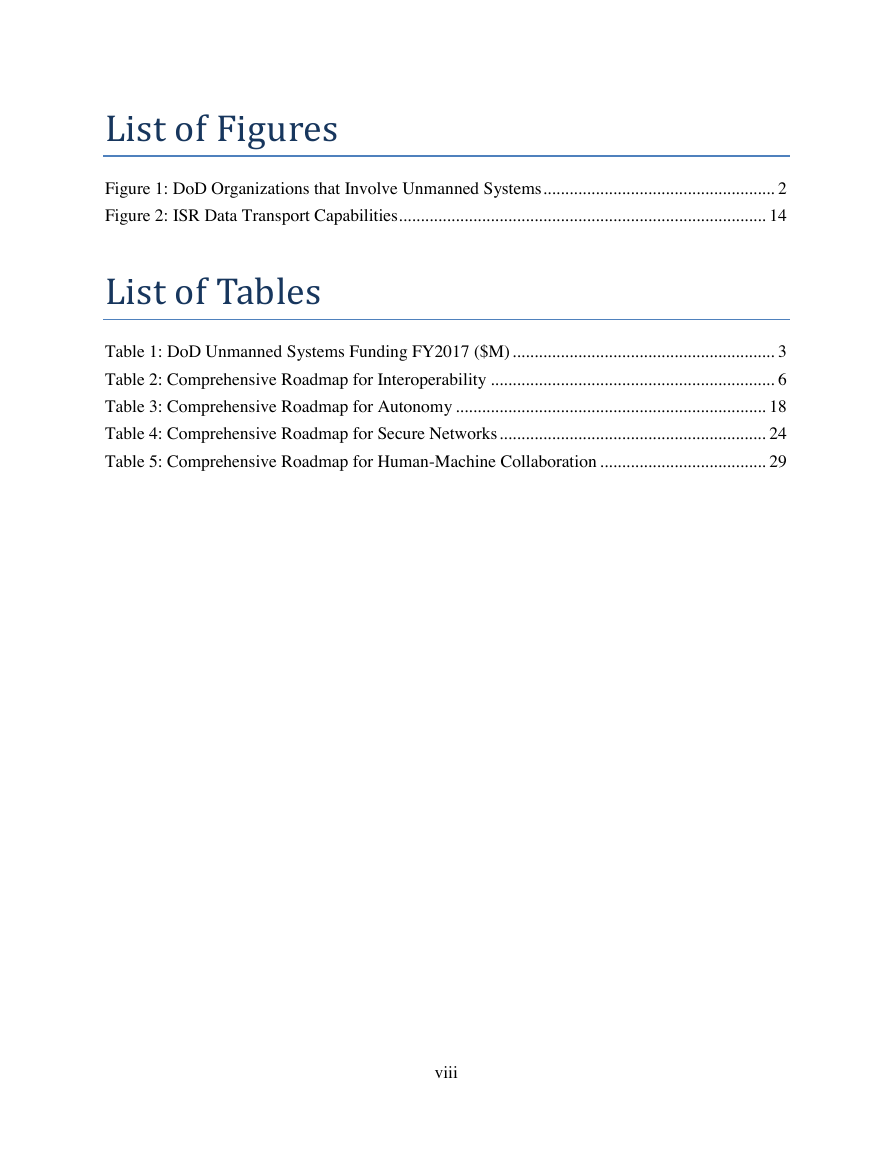Statement A. Approved for public release: distribution unlimited.
i
�
This page intentionally left blank.
ii
�
�
This page intentionally left blank.
iv
�
Executive Summary
The Office of the Secretary of Defense (OSD) and the Armed Services have made
extensive efforts to incorporate unmanned systems into their existing organization structures,
showing the integral importance that unmanned systems considerations represent. There is still
room for improved collaboration throughout the Department of Defense (DoD). Standardizing
the ongoing efforts, cooperating whenever possible, and consolidating the foundational policies
and technologies will enable the seamless teamwork that highlights future defense operations—
whether the teams are manned, unmanned, or combined.
The progress in unmanned systems technologies has highlighted the need to transition the
focus from specific domains to become domain agnostic. Advances in any domain are beneficial
across all domains. Future operations will rely heavily upon multi-domain capabilities that must
interface and integrate seamlessly into a Joint Force structure.
DoD, industry, and academia have advanced technologies, strategies, and standards that
challenge the evolution of unmanned systems and their integration into the DoD mission. These
major advancements, challenges, and trends can be consolidated into four critical themes, which
address foundational areas of interest that will continue to accelerate unmanned systems into the
future:
Interoperability – Interoperability has historically been, and continues to be, a major
thrust in the integration and operation of unmanned systems. Manned and unmanned
systems have increasingly synergized their capabilities, focusing on the critical need to
use open and common architectures. A robust interoperable foundation provides the
very structure that will allow for future advances in warfighting.
Autonomy – Advances in autonomy and robotics have the potential to revolutionize
warfighting concepts as a significant force multiplier. Autonomy will greatly increase
the efficiency and effectiveness of both manned and unmanned systems, providing a
strategic advantage for DoD.
Network Security– Unmanned systems operations ordinarily rely on networked
connections and efficient spectrum access. Network vulnerabilities must be addressed to
prevent disruption or manipulation.
Human-Machine Collaboration – If interoperability lays the foundation, then human-
machine collaboration is the ultimate objective. Teaming between human forces and
machines will enable revolutionary collaboration where machines will be valued as
critical teammates.
The supporting policy, requirements, and acquisition environments must continue to
evolve and advance to keep pace with the rapid technical and capability advancements of all
systems. To ensure our military advantage, emphasis should be placed on the evolution,
availability, and employment of unmanned technology. Alignment of DoD initiatives in
unmanned systems will influence the future makeup of the U.S. military.
v
�
This page intentionally left blank.
vi
�
Table of Contents
1
Introduction ............................................................................................................................ 1
1.1 Purpose ................................................................................................................................ 1
1.2 Themes and Enablers .......................................................................................................... 4
2
Interoperability ....................................................................................................................... 6
2.1 Common/Open Architectures ............................................................................................. 6
2.2 Modularity and Parts Interchangeability ............................................................................. 7
2.3 Compliance/Test, Evaluation, Verification, and Validation ............................................... 9
2.4 Data Transport Integration ................................................................................................ 11
2.5 Data Rights........................................................................................................................ 16
3
Autonomy ............................................................................................................................ 17
3.1 Artificial Intelligence and Machine Learning ................................................................... 18
3.2 Increased Efficiency and Effectiveness ............................................................................ 20
3.3 Trust .................................................................................................................................. 21
3.4 Weaponization .................................................................................................................. 22
4
Secure Network .................................................................................................................... 24
4.1 Cyber Operations .............................................................................................................. 24
4.2 Information Assurance ...................................................................................................... 26
4.3 Electromagnetic Spectrum and Electronic Warfare .......................................................... 27
5
Human-Machine Collaboration ........................................................................................... 29
5.1 Human-Machine Interfaces ............................................................................................... 29
5.2 Human-Machine Teaming ................................................................................................ 31
6
Summary ……………………………………………………………………………..........33
6.1 Challenges Summary ........................................................................................................ 33
6.2 Way Ahead Summary ....................................................................................................... 33
6.3 Key Technologies ............................................................................................................. 34
Appendix A
FOUNDATIONAL DOCUMENTS AND REFERENCES ................................ 36
Appendix B
JOINT CONCEPT FOR ROBOTICS AND AUTONOMOUS SYSTEMS ....... 38
Appendix C ACQUISITION INITIATIVES ........................................................................... 40
Appendix D OSD INITIATIVES ............................................................................................ 43
Appendix E ABBREVIATIONS ............................................................................................. 45
vii
�
List of Figures
Figure 1: DoD Organizations that Involve Unmanned Systems ..................................................... 2
Figure 2: ISR Data Transport Capabilities.................................................................................... 14
List of Tables
Table 1: DoD Unmanned Systems Funding FY2017 ($M) ............................................................ 3
Table 2: Comprehensive Roadmap for Interoperability ................................................................. 6
Table 3: Comprehensive Roadmap for Autonomy ....................................................................... 18
Table 4: Comprehensive Roadmap for Secure Networks ............................................................. 24
Table 5: Comprehensive Roadmap for Human-Machine Collaboration ...................................... 29
viii
�
















 2023年江西萍乡中考道德与法治真题及答案.doc
2023年江西萍乡中考道德与法治真题及答案.doc 2012年重庆南川中考生物真题及答案.doc
2012年重庆南川中考生物真题及答案.doc 2013年江西师范大学地理学综合及文艺理论基础考研真题.doc
2013年江西师范大学地理学综合及文艺理论基础考研真题.doc 2020年四川甘孜小升初语文真题及答案I卷.doc
2020年四川甘孜小升初语文真题及答案I卷.doc 2020年注册岩土工程师专业基础考试真题及答案.doc
2020年注册岩土工程师专业基础考试真题及答案.doc 2023-2024学年福建省厦门市九年级上学期数学月考试题及答案.doc
2023-2024学年福建省厦门市九年级上学期数学月考试题及答案.doc 2021-2022学年辽宁省沈阳市大东区九年级上学期语文期末试题及答案.doc
2021-2022学年辽宁省沈阳市大东区九年级上学期语文期末试题及答案.doc 2022-2023学年北京东城区初三第一学期物理期末试卷及答案.doc
2022-2023学年北京东城区初三第一学期物理期末试卷及答案.doc 2018上半年江西教师资格初中地理学科知识与教学能力真题及答案.doc
2018上半年江西教师资格初中地理学科知识与教学能力真题及答案.doc 2012年河北国家公务员申论考试真题及答案-省级.doc
2012年河北国家公务员申论考试真题及答案-省级.doc 2020-2021学年江苏省扬州市江都区邵樊片九年级上学期数学第一次质量检测试题及答案.doc
2020-2021学年江苏省扬州市江都区邵樊片九年级上学期数学第一次质量检测试题及答案.doc 2022下半年黑龙江教师资格证中学综合素质真题及答案.doc
2022下半年黑龙江教师资格证中学综合素质真题及答案.doc